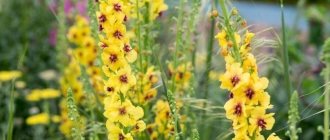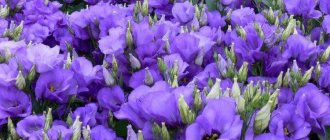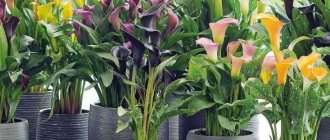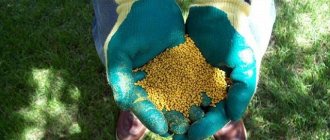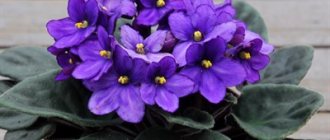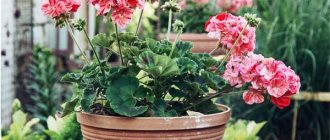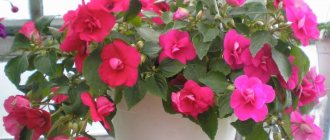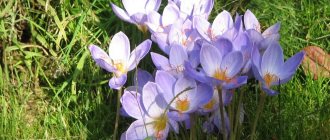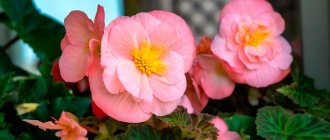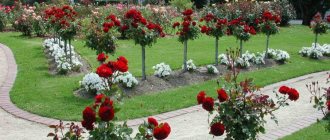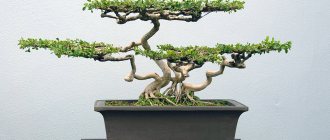Brugmansia is a beautiful flowering shrub from the nightshade family. Under natural conditions it reaches a height of 4-5 meters.
When grown in a room about 2 meters. Valued for its large, funnel-shaped flowers, the length of which can reach 40 cm. Depending on the type and variety, they can be simple, double, or even two-tiered. In warmer regions, Brugmansia can be used as a garden crop. In most Russian regions it is cultivated as a pot or indoor plant. Brugmansia is native to the tropics and subtropics of South America. There are 7 wild species found there. All modern garden forms and hybrids were developed on their basis.
Be sure to pay attention to the beautiful Beloperone plant.
| Growth rate is average. |
| Basically, it blooms all summer, but if illuminated in the evening, it can bloom until winter. |
| Average difficulty of growing. |
| It is a perennial plant. |
Angelonia - a flower with an angelic character
The work is posted: “My favorite variety”
Meet Angelonia.
Initially I was attracted by the title. Like many people, I thought it came from the word “angel.” But no! It comes from the name of the "angelon" people in Caracas, Venezuela. This beauty also grows in South and Central America, in Mexico. In warm countries it is a perennial, but in our country it is an annual or indoor flower. There are several varieties: both tall (60 cm) and lower (20-30 cm). I have Serenita. Compact form, up to 30 cm tall, color - purple, crimson or white. Angelonias are also called “poor man’s orchids” because of the similarity of the flowers to orchid flowers. Personally, I don’t find much similarity, but that’s good: orchids are “not my flowers.” This flower captivated me with its unpretentiousness. Truly angelic character. This can be especially appreciated in hot climates. My little angels forgive me for “forgot to water” and “didn’t feed me.” Agree - this is important! They also grow well in the scorching sun, both in a flower bed and in a plastic flower pot. At our + 30 +40, not a single plant withered, requiring watering. Aphids do not settle on it, snails do not eat it. (Or am I just so lucky!?). Seriously, angelonias are very resistant to diseases and pests. They look beautiful with stones and require a minimum of soil. Angels grow wonderfully in a container. They do not require cutting, pinching or shaping. If you cut off a faded peduncle, the angelonia immediately produces a new one. Grows in a neat, compact bush. When sown in mid-February, it blooms at the end of June and blooms until frost. Disadvantages include slow growth at the seedling stage. I sow in mid-February at the same time as petunias and lobelias. I spread the seeds on the surface of the soil and do not sprinkle them, as they need light. I water it carefully, cover it with film and put it in a warm place (~22 degrees). Shoots appear in five to six days. I remove the film and put it under the phytolamp. Temperature ~ 18-19 degrees. And so on until the beginning of April, then on the windowsill. For picking, I expect not 2 leaves, but 4-6. Angelonias have small roots, compact plants, and are easy and pleasant to work with. April 22 Tops and roots The picking is over. The seedlings are not capricious, they tolerate picking well. In mid-May, I planted the rosemary, partly in a flower bed, partly in flower pots with neutral soil and acidic soil (for hydrangeas). Be careful, angelonias do not tolerate frost! The first flowers From the beginning of July, the angels show themselves in all their glory. These were pots with acidic soil. The flowers turned out lush and not very tall. Although we gained the promised 30 centimeters. In a flowerbed Angelonia can also be grown as a young plant if you bring it indoors for the winter and care for it like a houseplant. Also in this case, you can propagate it by cuttings. I will describe this process in my next work, in winter... I hope you liked the angelic character of this pretty flower. Thank you. The online store Seedspost.ru invites you to familiarize yourself with the Flower Seeds catalog, where you can choose and purchase any seeds you like, including Angelonia Serenita
Growing Angelonias as a Perennial
Angelonia does not have to be grown only as an annual plant. It cannot stand even the slightest frost, but it is quite possible to preserve it from year to year. After flowering, it is enough to dig up the angelonias and plant them in pots (if they are not already growing in containers) and take them to the rooms. By growing it in the cold season as an ordinary houseplant, and just watering it regularly, maintaining light soil moisture, you will ensure that next year the bush will continue its life in the garden.
If you want to decorate your rooms with winter-blooming angelonias, the plants need to be prepared in advance for moving to other conditions. In August, all shoots should be cut in half, and in September the pots should be taken indoors. With normal watering, angelonia will bloom again in November. Unfortunately, after such repeated flowering, angelonia will not be able to survive another year, but it will still be useful as a mother plant for cuttings. It is enough just to prune the shoots in February by cutting cuttings - and you will have a new generation of angelonias for the garden.
Flowerbed with angelonias. © gsheehan
Angelonias can be grown not only in the garden in open soil or pots, but also in indoor culture. These are living bouquets that have no equal in beauty in a summer interior. Angelonias have a fairly compact rhizome and are content with a minimum of soil. That is why they feel equally good both in pots and in the flower garden.
Brief description of cultivation
- Temperature regime . In summer, the air temperature should be close to room temperature, and in winter - no more than 15 degrees.
- Air humidity level . It must be increased (at least 60 percent).
- Illumination . Needs plenty of bright but diffused sunlight. A south window is ideal, but the bush needs shading.
- Watering . The soil mixture in the pot should be slightly moist all the time.
- Substrate . Nutritious and light, a drainage layer must be placed at the bottom of the pot.
- Fertilizer . Needs regular feeding.
- Transplant . Carry out as needed, sometimes two or three times a year.
- Reproduction . By apical cuttings and seed method.
- Trimming . Requires systematic formative pruning.
Brugmansia in the flower garden. Care, reproduction, diseases, pests.
The angelic beauty of one of the most impressive flyers
When angelonias are ranked among the most beautifully flowering annuals, there is no question of any exaggeration. This is a unique annual plant whose beauty is simply mesmerizing. Angelonia is a real aristocrat. And its decorative features are best characterized by its popular nickname - “poor orchid” . Each individual flower of this plant is most similar in shape and beauty to orchids. Only the size of each flower is much smaller. But there are much more flowers in the inflorescences than in indoor princesses.
Angelonia. © Chris A
Outwardly, angelonia is a little reminiscent of diascia, but its shoots are not ampelous and flexible, but upright and rather rigid. Among gardeners who have already discovered this beauty thanks to exhibitions and fairs, it is also known as the “ flower with an angel’s face .” In its homeland, in hot Mexico, angelonia is popular as a summer snapdragon.
Angelonias are a large genus of ornamental plants, including more than 30 species. Today in landscape design, Angelonias are represented by variety mixtures and variety groups, usually of hybrid origin, bred on the basis of Angelonia angustifolia . It is best to choose angelonias based on the color of the flowers from the seeds or seedlings available to you.
The main advantage of angelonias is their very long and spectacular flowering. This annual plant does not bloom from spring until frost, but does not know competitors all summer. But the duration pales in comparison to the originality of the flower shapes. A unique feature of angelonia is the ability to produce new flower stalks even at the end of flowering. It not only opens the buds of already formed flowers, but after cutting off the faded shoots it produces full-fledged new ones.
Bouquet of Angelonia in a vase. © cdanna2003
The color range of angelonias is also very representative. The flowers of the plant are painted in various shades of purple, white, pink, blue, while different flowers sometimes combine several shades, and most angelonias have a watercolor color, with transitions from light to more intense.
Angelonia is an excellent cut crop. In terms of the grace and beauty of its inflorescences, it can compete with any greenhouse or hothouse plant. She is especially good in large bouquets. Angelonia flowers do not fade for more than 10 days and emit the same apple-like aroma with a slight grape tinge as the leaves when rubbed. You will never find such an airy and lacy plant again.
Properties of Brugmansia
Where Brugmansia comes from, the local population widely uses it as a medicinal plant. It has hallucinogenic properties that are used for religious rituals. Remember that each part of the plant contains a strong poison, or rather, they contain atropine and scopolamine in high concentrations. The flowers of this plant have a pungent odor, which can cause severe headaches.
BRUGMANSIA//My many years of experience in propagation by cuttings, planting, transplanting and preserving in winter.
How is planting in open ground carried out?
Planting Brugmansia and caring for it in open ground is not particularly difficult; even an inexperienced gardener can cope with it. The culture prefers bright and warm places, so growing it year-round in the garden (especially in areas with a cold climate) is prohibited. Even with mild winters, the crop takes a long time to recover from the cold and does not have time to bloom normally by summer.
How does the Angel's Trumpet flower overwinter? If a gardener wants to grow this plant in the garden, then in winter he will have to bring it indoors. Planting in the soil involves transferring the flower in the fall into a large tub together with a lump of earth and growing it in the winter in a room, which can be a winter garden or a simple apartment.
In spring, as soon as the air temperature rises to 10 degrees and the danger of night frosts disappears, the plant is transferred back to the garden, where it quickly adapts and soon begins to delight the gardener with beautiful and lush flowers.
The main disadvantage of growing according to this principle is the root system, which grows greatly over the summer, which complicates its transfer and cultivation indoors in cold weather.
Brugmansia
Brugmansia is a genus of plants from the Solanaceae family. This includes small trees and shrubs. The genus is named after the Dutch botanist Sebald Justinus Brugmans. The genus includes 10 species. The plant is sometimes mistakenly classified as a Datura genus; be careful when purchasing seeds. Unlike Datura - annual herbaceous plants, Brugmansia - shrubs.
Brugmansia appeared in Russia recently, most often found on sale under the general name “Trumpets of Angels” (Angel Trumpet). This is a powerful, very beautiful and lushly flowering plant. Brugmansia can reach 5 meters in height, so immediately choose compact or slow-growing varieties (Culebra, Cordata Red). Giant tubular-bell-shaped flowers reach a length of up to 50 cm and a diameter of up to 20 cm, and have a pleasant aroma that intensifies at night. The colors of the flowers are varied - yellow-green, yellow, cream, peach, pink, orange, red and various shades of these colors. It can be multi-colored. There are varieties with double and semi-double flowers. The leaves are oval, elongated, and also reach a length of up to half a meter.
Choosing a pot for Brugmansia
It is better to grow young plants in massive clay pots so that they are not knocked over by the wind. Large, heavy specimens are easier to manage if they are planted in plastic containers. The size of the container increases as it grows to 15-30 liters or more. Black pots are wrapped in light material to protect the Brugmansia root system from overheating.
Soil for Brugmansia
Brugmansia prefers a very bright place, but shaded from the midday sun. The plant must be protected from strong winds. Requires light fertile soil. The soil mixture is best prepared from 1 part fertile loam, 1 part humus or compost and 2 parts peat. The mixture is thoroughly mixed, placed in a pot and poured well with a warm pink aqueous solution of potassium permanganate. Brugmansia will develop well in such soil. If purchased soil is used, at least half the volume of compost or humus, or fertile loamy soil should be added to it.
Brugmansia care
In summer, it is advisable to keep Brugmansias in the garden. Gradually accustom the plants to bright light and provide protection from direct sunlight. During the growing season, Brugmansia forms a huge mass of leaves and flowers. Fertilize with liquid fertilizer 2-3 times a week. Weak flowering is usually explained by insufficient fertilizing. For Brugmansias, a high concentration of nutrient salts is acceptable. Brugmansia reacts to a lack of nutrients by changing the color of the leaves. For example, their yellowing is caused by a lack of magnesium. Eliminated by additional application of magnesium sulfate (1 g/l) during irrigation.
Watering Brugmansia
The reason for the death of most indoor plants is non-compliance with the watering regime. If there is too much water, the water stagnates in the pan and the roots begin to rot. Brugmansias are moisture-loving and need daily spraying in the summer, but the roots should not get wet. Before watering, check the soil by touch or by the weight of the pot. You should water only when the surface of the soil dries out slightly.
In summer, Brugmansia is watered abundantly, avoiding stagnation of water in the substrate. In winter, water so that the soil does not dry out. The pot is wrapped in plastic film, which retains moisture in the root area. The surface of the substrate is left open, but mulched.
Winter content
In the conditions of the middle zone in open ground it can grow only in summer; for winter it needs to be moved to a cool room or a warm greenhouse (+5...+12 ° C). The colder it is, the less Brugmansia needs light and water. The warmer it is, the more moisture and sun you need. In the cold, Brugmansia partially loses its leaves and goes into a dormant state. In warm conditions with good lighting it continues to bloom. For the winter, you can move it to the south window and place it where it is cooler; large plants can be placed on the floor by the window. In such conditions there will be no complete rest, so about once every 3 weeks continue to fertilize and install fluorescent lamps.
Reproduction of Brugmansia
The most effective method of propagation is spring and summer cuttings using apical semi-lignified cuttings. Young plants bloom in the first year. A good way is to root root cuttings remaining when replanting plants.
CARE RECOMMENDATIONS
A bright place, protected from direct rays. In summer, outdoor maintenance
Flowering plants require balanced feeding every 3-5 days.
The garden needs protection from caterpillars and slugs.
Possibility of growing as a perennial
Angelonia growing from seeds at home
Angelonia will not survive the cold winter of the middle zone. But it has a fairly compact root system and does not require a large volume of soil either. These factors are enough for it to feel comfortable in a pot and acquire the status of a perennial plant.
Then there are two options for the development of events:
- Save angelonia for the winter period, and next year plant it again in open ground. After completing the flowering phase, it is enough to dig up the plant, place it in containers or pots, take it home and keep it in conditions for ordinary indoor plants.
- Use as a winter flowering house plant. In this case, Angelonia needs to be prepared in advance for a change of residence. In August, the shoots are cut in half, a month later they are transplanted into pots and taken into the house, caring for them as if they were a houseplant. After some time it will bloom again.
But this method has a key drawback - while enjoying winter flowering, you will have to sacrifice the plant for the next year. But by pruning the shoots in February, you will get excellent cutting material for a new generation of plants.
Conditions for the growth of indoor Brugmansia plants
Brugmansia, as an indigenous inhabitant of the South American tropics, is very thermophilic and reacts sharply to temperature changes, dropping foliage and stopping the formation of buds. A temperature within 23–28 °C is considered comfortable, and the first signs of discomfort are noticeable already when the temperature drops by 8–10 °C. Closer to zero, Brugmansia first stops the growing season, and then the above-ground part of the tree dies.
To maintain the attractiveness of the plant throughout the year, when caring for Brugmansia at home:
- try to maintain a constant temperature;
- protect the plant from drafts;
- provide bright and long-lasting lighting;
- carry out regular watering and fertilizing, the schedule of which depends on the vegetative activity of the indoor flower;
- trim the crown and replant the plant when it “outgrows” the old pot.
In the summer, when there is no danger of frost, cold wind or rain, it is useful to take the Brugmansia pot out into the fresh air.
Brugmansia loves the sun and feels great not only on the eastern or western side, but also on the south side. Only on the sunniest days, at midday, the plant may droop slightly, which can be easily corrected by watering and moving the pot a meter deeper into the room.
If a Brugmansia indoor plant is kept indoors all year round, from autumn to spring, and also when located away from a window, the flower needs additional lighting. When kept in cold conditions in winter, for example in a basement with a temperature of about 10 °C, light is not required at all.
Features of cultivation
In the southern regions, Angel's Trumpets are planted in the soil. In winter, the above-ground part of the plant dies, but the root system itself remains until spring, after which new shoots bloom from it.
Wild Brugmansia can reach a height of 5 meters; among indoor varieties there are smaller varieties. The leaves of the crop are large, oval in shape, with wavy edges (reach 1.5 meters in length). Flowers can be bell-shaped, funnel-shaped, elongated and large - up to 20 centimeters in diameter, up to 50 centimeters in length.
The color of flowers directly depends on the variety; it can be yellow, cream, red and even orange, which gives the gardener the opportunity to choose any color for himself. Among the new varieties, two- and three-color flowers are distinguished. The aroma of the plant is quite bright, becoming stronger in the evening and at night.
The poisonous properties of the Angel Trumpets flower have a psychotropic effect, which is important to consider when growing the crop in an apartment. For normal growth and flowering, the flower should be provided with a cold winter. Brugmansia in a pot should not be grown in a home where there are young children and pets. Plants should be placed in a room away from the bedroom. The psychotropic effect becomes stronger at night.
How to properly grow Brugmansia in a pot
Brugmansia cuttings can be purchased all year round, but usually amateur gardeners purchase them in the spring.
At the same time, it must be taken into account that the cutting can be in the form of a rooted Brugmansia stem, or the upper cutting of the plant can be rooted.
Brugmansia is a gourmet; it loves very rich soil with a lot of humus and microelements.
Therefore, if you decide to have this beauty at home, stock up on the best soil.
It is impossible to overfeed this plant, since everything is only for its benefit, the PH (acidity) of the soil has absolutely no effect on brugmansia, but if you add a little dry chicken droppings, it is the ambrosia of the soul for this flower.
let's move on to landing
-we purchase a decent size pot, since the plant grows very quickly;
- as it grows, we transfer the grown Brugmansia, without destroying the earthen lump, into a larger container;
- constantly add fresh soil + dry chicken droppings (in small quantities).
how to water correctly
- so that the water in the pot does not stagnate, place expanded clay on the bottom;
- in growing conditions in hot apartments, and the air here is quite dry, Brugmansia must be watered daily and abundantly;
-increase air humidity indoors, especially during the heating season.
how to properly fertilize
-to improve flowering, in May, feed the flower with phosphorus-potassium fertilizer;
- once every two weeks, fertilize with soluble flower fertilizer without chlorine, such as Fertik.
what kind of lighting does brugmansia need?
- in winter, when there is not enough sunlight, use energy-saving 40 Watts as a light source. light bulbs, 2-3 pieces. This amount of light is enough even for flowering plants.
Home care
Watering
Irrigation should be plentiful in summer and moderate in winter. If the weather is hot in summer, water the plant every other day or daily. In winter, at a temperature of 16-18 degrees, water 2-3 times a month. This variety of pelargonium is dry-resistant , which means it is able to accumulate moisture. It is necessary to ensure that the soil is not over-moistened during watering. Otherwise it will harm the root system. You should not spray the plant when flowering, as this will have a detrimental effect on the flowers.
Illumination
Geranium Angel needs quite a lot of light. Only then will they develop normally, bloom profusely, and their foliage will be healthy and juicy. In summer, the plant needs to be shaded, and in winter, light should be added using artificial sources. In a dark place, flowering stops or stops completely, the stems begin to stretch, and the leaves fade.
Temperature
During flowering and growth, the flower feels comfortable at a temperature of +20-+25 degrees. During dormancy (October-February), the variety requires coolness. The optimal temperature remains +12- +15 degrees. If you keep pelargonium in a warm room in winter, then water it in the same way as in summer, just do not feed it.
Fertilizers and fertilizers
From spring to autumn, when active flowering of the Angel is observed, it is necessary to apply fertilizing.
Do this 2 times a month. Liquid formulations are best. Place them in slightly moist soil. Choose fertilizers that contain nitrogen, potassium and phosphorus. To obtain abundant greenery, you need to choose fertilizer with a high concentration of nitrogen. And for abundant flowering, the composition must contain potassium and phosphorus. Liquid fertilizer Pelargovit is excellent. Apply it in the dosage and at the frequency indicated on the package.
How to grow such vines?
Sowing for seedlings
Growing quamoclite from seeds involves sowing them in greenhouse conditions to obtain seedlings.
As a rule, seeds are sown in March, in cold spring and during prolonged frosts. Before planting in the ground, it is worth soaking the seedlings in warm water and leaving for about a day. For planting, you can use peat pots or a universal flower mixture. Seedlings are planted in boxes that already contain soil to a depth of no more than 1 cm, and the soil is lightly watered from above. Next, seed germination is expected. Shoots will appear on about 10–14 days, provided that the temperature during this period is 18–20 degrees (see photo).
Shoots obtained under indoor conditions must be pruned. This process is carried out with the appearance of the first leaves. Morning glory in the form of seedlings is planted in a permanent place in the garden in May. In this case, you should not remove the soil from the roots, but just place it in the ground with a lump.
Planting in open ground
Morning glory vines can be grown from seeds directly in open ground.
To do this, seedlings are planted in May at a distance of 35-50 cm. To prevent possible frosts and temperature changes from adversely affecting the seedlings, the planted area is covered with synthetic material. If possible, it is even worth building something like a greenhouse. The soil that is suitable for growing flowers of the Ipomoea Kvamoklit genus can be loose and sandy, or rich in humus. This plant can also be kept in soils with a different composition, but its condition and growth will be worse. Before planting, the soil should be fertilized with organic matter.
Growing quamoclite
In general, growing quamoclite is quite common. And some types of vines from the Kvamoklit family, classified by flower growers as belonging to the genus Ipomoea, have become the most popular for propagation from seeds on their own:
- Bladed;
- Pinnate;
- Fiery red;
- Slaughter's Quamoclite (see photo).
Beautifully climbing vines, forming dense flowering “curtains”, can grow reaching 2-2.5 meters in height. Combining the universal properties of ornamental vines and plants with beautiful flowering, Ipomoea Kvamoklit will undoubtedly attract attention to your garden.
Kvamoklit (Ipomoea) is an annual plant with twisting vine stems growing from the ground and bright flowers with a diameter of 2 to 3 cm, similar to stars, this can be seen in the photo.
The pinnate quamoclite, also called the cypress vine, can grow up to 3 meters in height. Its leaves are dark green in color and dissected so that they resemble a fan.
This delightful plant, which came from America, has been popular in European countries for more than 400 years. The overseas flower was able to adapt to cool conditions very quickly. As a result, by growing quamoclite from seeds, over the summer you can not only get full-fledged vines and admire their color, but also collect “fruits”.
Features of cypress vine
The most common quamoclite in floriculture is Cirrus, although its cultivation differs from other varieties represented by the genus Ipomoea.
For example, he does not tolerate transplants. And it reproduces better by seeds, which should be planted only in open ground after the frost period has passed. It is better to sow Cirrus quamoclite at the end of April. If planting is done later, the morning glory will not have time to ripen. Of course, in cases where the winter period is very prolonged, flower growers begin to germinate seeds at home in order to obtain seedlings. In principle, in this case, planting can be carried out in March, in prepared pots with universal soil. Further cultivation includes the obligatory picking of seedlings and planting seedlings in the open air at the end of May.
Cirrus quamoclite is planted in the form of seedlings, like other plants of the family called Morning Glory, in small grooves with a depth of 3 to 5 cm. The optimal distance between seedlings that should be maintained during transplantation is 10 cm. At the same time, the sprout does not need to be deepened into the ground .
Growing from seeds
The plant is grown from seed. Planting is carried out in February in pots. For this, a loose substrate is used, which must first be disinfected. The soil is treated with some kind of fungicide. Next, the seed is sown. The seeds are planted in a checkerboard pattern at a distance of 3 cm from each other. For this, very loose soil is used. They do not need to be sprinkled with soil; it is enough to cover them with a thin layer of soil. To sprout, a seed needs light. Angelonia should be sown at room temperature. After 1-2 weeks you will see the first shoots, after that reduce the temperature. After the sprouts appear, the temperature is reduced to 18 degrees.
Angelonia angustifolia seedlings are watered moderately. Overmoistening of angelonia is not allowed. It is necessary to cover the plants with film or grow them under glass. Before planting in the ground, angelonia is watered several times with nitrogen-containing fertilizers, for example, saltpeter. The seedlings are transferred to the ground when there is no longer frost. Usually this is at the end of May.
Please note that the root of the flower is a taproot, so when digging it up, you must not damage it.
Purple angelonia flowers
Advantages of Angelonia:
- beauty;
- long flowering period;
- unpretentiousness;
- opportunity to grow a perennial plant.
In theory, angelonia is an annual, but with proper care it will delight you for many years. If you want to enjoy the “poor orchid” next year, cut off half the shoots and remove all the flowers at the end of August. In September, transfer the roots to a pot and take them to the cellar or cool room. Moisten the soil occasionally.
Angelonia on wooden background
If you want to enjoy angelonia indoors in the winter after flowering in the garden, cut off all the flowers in early autumn and replant the plant in a pot. Water deeply and you will see beautiful flowers in November. You can see what they look like in the photo. It is worth noting that after winter flowering there is no point in replanting the plant in the garden. It will no longer bloom. Angelonia flowers have a certain number of uterine buds that produce buds; when the reserves are exhausted, the plant does not bloom.
How to save a tree in winter
Ideally, you need to dig up the tree, plant it in a huge pot and transport it to the winter garden for the winter.
Continue to take care of Brugmansia under the same conditions as in the apartment.
But winter gardens are rare, so a huge bush, which often has several trunks, is divided into several parts (according to the number of trunks) using a shovel, each piece is moved into its own pot and moved to a cool room, possibly to the basement.
In winter, water very rarely, fertilizing is removed, the main thing is not to dry it out.
Brugmansia, although considered a sissy, is actually a resilient tin soldier.
The plant is very tenacious, grow this beauty in your area.
Brugmansia flower: planting and care in open ground
The plant is very heat-loving, so it is not possible to grow it all year round in the garden (in regions with cold winters). Even with very mild winters, it takes a long time to recover after a cold period, and if you decide to grow this magnificent flower in open ground, then it must be brought to a warm place for the winter.
Planting in open ground involves transferring the flower in the autumn into a voluminous tub along with a lump of earth and installing it in a room for the winter, which can be a winter garden or an ordinary apartment.
In the spring, as soon as the air temperature reaches more than +10 degrees and the threat of night frosts has passed, the beauty is placed back in the garden plot, where it will delight its owners with lush flowering.
The disadvantage of such cultivation is that the root system of the plant grows greatly over the summer, and Brugmansia itself becomes impressive in size, which makes it difficult to keep it indoors in winter. And if you keep the flower in a tub all year round, it will not bloom as profusely as in open ground.
Brugmansia pink in the photo
Actions after acquiring Brugmansia: transportation, replanting, selection of soil and container
Brugmansia is a voluminous bush, a tree that takes up enough space, so for growing in a small garden it is preferable to choose indoor varieties. Due to the pungent, poisonous aroma, it is recommended to grow the crop in open ground. After purchasing, the seedling is planted in a garden or a large pot and placed in the yard. Since Brugmansia is heat-loving, it is transferred to a cool room for the winter. The size of the container increases with the growth of the root system. For planting, it is recommended to choose slightly alkaline or neutral acidity soil.
How to grow angelonia from seeds
Angelonia growing from seeds photo
Obtaining seedlings from seeds is a popular way to propagate a plant.
- To do this, the seeds must be sown early, in February - early March.
- Angel flower seeds are photosensitive; they are not buried in the soil, but scattered over the surface.
- Then the container with future seedlings is covered with film or glass and germinated at an average temperature of 21-25 degrees.
- When seedlings appear, the temperature is reduced to 18-20 degrees.
- It is necessary to constantly monitor the temperature, otherwise there is a high probability of stopping the growth and development of angelonia seedlings.
- It is important to ensure sufficient soil moisture during the germination stage.
- When the first 2 true leaves appear, it’s time to plant them in separate suitable containers.
- Sometimes additional illumination with phytolamps is required (about 10 hours).
- Seedlings need to be fed with mineral fertilizers.
- Planting in open ground is carried out only after the threat of frost has disappeared, around the end of May. And they can bloom very soon - in June.
Angelonia seedlings photo
As for the second method of propagation, cuttings , it is only possible when angelia are wintered at home. Reproduction is easy; it is enough to cut the apical cuttings, which will take root without problems in conditions close to greenhouse conditions within 7-14 days.
Brugmansia care rules
The information presented below concerns Brugmansia care factors that should be considered before purchasing and planting a plant.
- Landing. Seeds are sown from mid-winter to early spring. Transplantation of seedlings into open ground is carried out at the beginning of summer.
- Temperature conditions. The bush is a heat-loving plant, so in warm weather it grows well at any temperature. In winter, Brugmansia must be moved to a cool (+8-12°C) room.
- Air humidity. You need to moisten the foliage regularly.
- Lighting. This bush is a light-loving plant and therefore requires high-quality bright lighting. It is recommended to avoid direct exposure to sunlight.
- Watering. Brugmansia is demanding of moisture, so in open ground it is watered abundantly. In winter, the amount of watering is reduced.
- The soil. It is recommended to choose soil that is rich in nutrients, light, and has good oxygen permeability to the root system. Brugmansia grows well in slightly alkaline or neutral soil.
- Rest period. It occurs from late autumn - mid-winter until early spring.
- Bloom. Brugmansia begins to bloom in July and ends in December.
- Feeding. Feeding the bush is carried out from May to August once a week. Brugmansia prefers complex mineral fertilizers. In winter, fertilizing is excluded.
- Transfer. It is carried out in the fall before the onset of cold weather.
- Trimming. It is mandatory to give the bush its shape. It is better to prune in early March before the sap flows in the branches.
- Reproduction. There are two ways - cuttings and seeds.
- Pests and diseases. Most often it affects spider mites, caterpillars, whiteflies, and slugs. Among the diseases is gray rot.
Common diseases and pests
Geranium Angel is most often affected by the following diseases and parasites:
- Blackleg. It damages the base of the stem. This happens due to excessive soil moisture or contamination. You need to get rid of the flower immediately. You can cut the plant. To prevent the development of the disease, you need to buy new soil, sterilize it and during further care do not over-moisten it.
- If the stems begin to stretch and the leaves fall off, this indicates a lack of light. You need to move the geranium to a bright place or consider artificial lighting.
- Gray mold. This is a fungal disease that occurs when a plant is infected with the Botrytis fungus. It is necessary to remove the affected leaves, treat the flower with a fungicide, reduce watering, and ventilate the room more often.
- Swelling on the leaves occurs when the soil is over-moistened. It is necessary to adjust the frequency and volume of watering.
- Whiteflies and aphids often attack Angel geraniums. You can get rid of them using products that contain permethrin. Use fungicides to control mites.
We will tell you about ivy-leaved geranium, which rightfully occupies a special place for every gardener, in these articles:
- How to take care of ampelous geranium and why is it called ivy-leaved?
- What kind of home care does ivy-leaved geranium require for spectacular flowering?
- Propagation of ampelous or ivy-leaved geranium.
- Careful cultivation of ivy-leaved geranium.
Watering and fertilizing indoor Brugmansia plants
Brugmansia has a well-developed crown, which:
- protects the soil under the flower from overheating and evaporation;
- participates in photosynthesis and helps the plant receive the necessary nutrition;
- To maintain tone, especially in hot sunny times, it requires a lot of moisture and nutrients.
Therefore, Brugmansia in a pot is regularly and abundantly watered, reducing watering only during cloudy weather and wintering. Watering the flower is carried out with warm soft water, soaking the entire earthen Komi and be sure to drain the excess that accumulates in the pan within 30–40 minutes.
For tropical plants, especially young specimens, the humidity of not only the substrate, but also the air is important. However, moisture on flowers and leaves can cause burns. To prevent this from happening, use the following to humidify the air:
- irrigation when the plant is in partial shade or in the evening;
- placing a container of water nearby;
- placing the pot on a tray with wet expanded clay;
- household humidifiers.
Fertilizing is carried out throughout the growing season. First, immediately after spring pruning, nitrogen fertilizers are applied to activate the growth of greenery, then they switch to complex mixtures that stimulate the formation of buds and lush flowering.
In warm weather, Brugmansia, when cared for at home, is fed at intervals of 7 to 14 days.
Main types of shrubs
Brugmania varieties can differ significantly from each other in the shape and appearance of their flowers. The following popular varieties are distinguished:
- Brugmansia fragrant. The flower is white or pale yellow, up to 30 centimeters long and directed downwards. The flowering of the crop is particularly abundant and, when grown in a greenhouse, can last 12 months. The shrub has a central trunk and sparse branches.
- Brugmansia golden. The flowers are presented in all shades of yellow, have a wide bend and are 30 cm long. The leaves are tapered and dark green in color.
- Brugmansia snow-white. It reaches a height of three meters. The leaves have a velvety structure, are 25 centimeters long and white in color.
- Brugmansia bloody is the most resistant species to low temperatures. The bright flowers are colored red, yellow and orange. The smell of this variety is not as strong as others.
- Brugmansia variegated. Long flowers bloom on the crop - 50 centimeters. They are painted in a cream color, which turns into peach over time.
Most often, flower growers choose the fragrant Brugmansia variety for growing in an apartment.
Simple care for a far from simple plant
When you admire the beauty of angelonia blossoms, its ideal bushes and graceful forms, it is far from easy to believe in the stamina and endurance of the plant. Angelonia seems to be saying with all her appearance that she needs careful care. But it is far from being so predictable.
This summer plant is completely drought-resistant and does not need to be watered. Just a few waterings on the hottest days during a long, relentless drought - and the angelonia will bloom even more magnificently. There is no question of any regular, systemic watering for this plant. If you did not water the angelonia or the combination of extreme heat and drought seemed excessive to it, the plant stopped developing and flowering; just trim the peduncles or remove the faded peduncles completely - and the angelonia will begin to grow again.
Pruning is an important component of caring for angelonias. But they will not need either shaping or thickening. All you have to do is cut the peduncle down to the base after the flowers have withered - and in its place the tireless beauty will quickly produce a new shoot with buds.
Angelonia, poor orchid. © Karen
Description
Interesting. The culture of the angelic group is distinguished by a compact, fluffy bush and a lemon aroma, expressed to varying degrees, depending on the variety.
Pelargonium Sutarves Klara San
The leaves of the plants are medium-sized, densely spaced, dissected, with pointed edges. The shade of the leaves is green.
Numerous flowers resemble “pansies” or Viola, which is why they are sometimes called violas. The flowers are simple, characteristic of this group, have two upper, large, rounded petals and three smaller lower ones, arranged in the form of a fan. Unlike the royal group, Angel flowers are small.
The stems of the plant are lignified; in different varieties they are upright or with a tendency to branching.
The bush usually does not reach 30 cm, but there are specimens up to 60 cm.
The color of the petals is spotted, interspersed and edged with combinations of white, pink, lilac, orange and burgundy shades.
Interesting. Pelargonium petals are never blue.
Bright spots of color are present mainly on the upper two petals.
Numerous flowers resemble “pansies”
Brugmansia in bloom
Finally, the long-awaited period of flowering has arrived, since Brugmansia has grown to the point of true maturity, there are flowers in the form of huge bells, their number is huge, one fades and another blooms.
And what a aroma - you can’t get enough of it, especially in the evening.
And the main advantage of Brugmansia in bloom is the flowering top cutting.
This cutting, even when separated from the mother plant, will continue to bloom and give new life.
Favorite varieties of Angelonia
Angelonia serena serena flower photo
Modern landscape design uses varieties of hybrid origin based on Angelonia angustifolia, whose stems reach up to 55 cm in height and inflorescences up to 20 cm. Dark green jagged leaves have a characteristic apple smell when rubbed. Depending on climatic conditions, they can bloom for up to 6 weeks or more.
Breeders are constantly improving their work, considering angelonia very promising: the bred varieties very often have a watercolor color or a combination of several shades. For example, the Hilo Beauty variety blue flowers with white streaks and silver foliage; The Serena variety comes in several colors: blue, purple, pink, lavender and white. But this is not the limit: a lower and brighter Serenita series (colors from crimson to white); Sungelonia series (less than 40 cm in height, blue, hot pink). Breeders are working not only on color, but also in the direction of more compact growth, stiffness of stems, and resistance to weather conditions.
Flower growers value angelonia for a combination of qualities that provide clear advantages over other annuals:
- Beauty. In addition to amazingly abundant flowers, angelonia is capable of forming a lush, self-sufficient bush, which does not require additional formation, since it already looks like a bouquet.
- Potential for a long flowering period. It has a fantastic feature: if you cut off a faded shoot, angelonia is able to produce full-fledged new flower stalks, even when the flowering phase is coming to an end.
- Unpretentiousness. With relative ease of care, the “poor orchid” can pleasantly surprise even when cut - the bouquet will last for at least 10 days, delighting not only with its appearance, but also with its light, refined aroma.
- Opportunity to grow a perennial plant. There are several ways that give the bush a chance not to die from frost, but to preserve it until next year.
Angelonia is an angelic flower, the seeds of which are sown for seedlings in January - February
Angelonias are perennial herbs that bloom with bright, beautiful flowers collected in an elegant cluster. This unusual name Angelonia is given to the plant by the name of the Angelon people in Caracas (Venezuela), where it was first discovered.
There are about 34 species of herbaceous plants and subshrubs in the genus; Angelonia angustifolia is mainly grown in cultivation. This plant is still little known, since the species was introduced into cultivation only in 1990 in the USA! Therefore, if you want to surprise your neighbors and friends at your dacha, then in addition to eustoma, be sure to sow angelonia seedlings. It is still quite problematic to buy ready-made angelonia seedlings in garden centers, although it is possible.
In Russia, angelonia is also known as
summer snapdragon . It is under this name that it can sometimes be found in shopping centers and seedling shops. So when you see snapdragon on sale, pay attention to its leaves, you may be very lucky! and you came across seedlings of the named angelonia.
Angelonia is an evergreen plant up to 45-55 cm high. It has interesting leaves - pointed, jagged, but most importantly, when rubbed, they smell like apples. Flowers can be of various colors: white, pink, lilac, purple, blue; there are already varieties with two-color colors. The flowers are collected in beautiful spike-shaped inflorescences from 8 to 20 cm long. Angelonia blooms from a month to one and a half and stands well when cut, up to 10 days.
In USDA zones 9-11, angelonia is a perennial plant, but in our country it is grown as an annual plant.
Beautiful varieties of angelonia
Angelonia Angelface - plant up to 60 cm high, blue-violet flowers;
Angelonia series F1 Serena - flowers of 5 colors (purple, lavender, blue, pink and white), 25-30 cm high;
Angelonia series F1 Serenita - height 20-35 cm, colors crimson, purple, lavender and white;
Angelonia series Sungelonia - plants less than 40 cm high, flowers are bright pink, white and blue.
Features of growing angelonia
Angelonia is unpretentious; a sunny place with moderate water conditions is suitable for planting. Responds well to feeding.
After the flowers fade, it is advisable to cut off the peduncle.
Sowing angelonia seedlings
Angelonia seedlings are sown in January-February. When sowing, the seeds are not buried, they are sown on the surface, and then sprinkled with a thin layer of soil or vermiculite.
Angelonia seedlings are planted in open ground in late May–early June, since the plant is very thermophilic.
Growing angelonia in a pot
For the winter, you can take the mother liquor with the angelonia plant home. Since it is naturally a perennial plant, it will grow well at home in a pot.
If you grow angelonia in a pot, then simply take the pot with angelonia home, and if in a flower garden, then carefully dig up the bush and transfer it to the pot, after cutting the plant to half its height.
In addition, angelonia is easy to cut (cuttings take root in just 2 weeks), so in the spring you will have not just one angelonia bush, but many.
